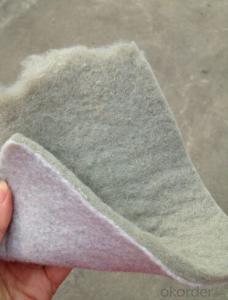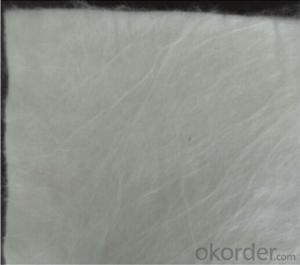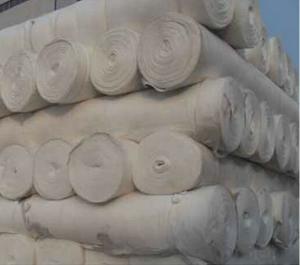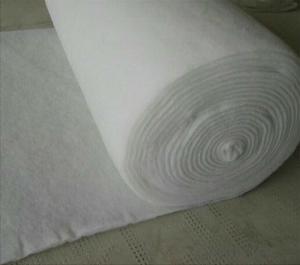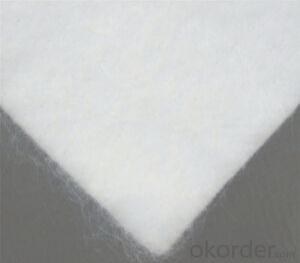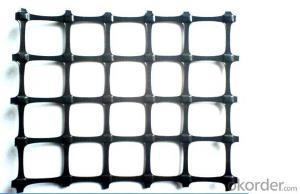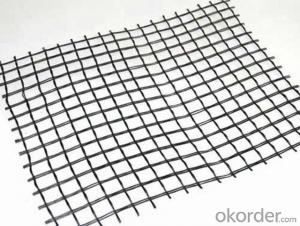Nutrition Geotextile Use in Ecological Prevention and Control
- Loading Port:
- Qingdao
- Payment Terms:
- TT OR LC
- Min Order Qty:
- 5000 m²
- Supply Capability:
- 2000000 m²/month
OKorder Service Pledge
OKorder Financial Service
You Might Also Like
Nutrition geotextile in water environmental engineering .
Specification:
1. 200g/m2-400g/m2
2. One side thermally bonded nonwoven geotextile
3. Both sides thermally bonded nonwoven geotextile
Product Feature:
1. Simple and fast construction
2. Achieve the greening effect quickly after construction
3. Due to the grass and composite fiber fabrics become into one integration, so it has the ability of certain degree of flow resistance for the water rising before the grass survive.
4. Composite fiber fabric is a continuous structure from slope top to slope toe, both ends are fixed, has high water flow resistance.
Technical Specification
5.0 m length and 1.05 m width. Reverse side all used filter material. Grass seeds: Bermuda grass (warm season grass), Bahia grass (warm season grass), Kentucky bluegrass (cold season grass), Tall fescue grass (cold season grass), Red fescue grass (cold season grass). Plant height: 0.1 ~ 0.5 m.
| NO. | Items | Specification | Notes | |||
| 1 | Total unit area weight g/sq.m | ≥380 | ||||
| 2 | dimension | width m | 1.0~2.0 | |||
| length m | as per user’s request | |||||
| 3 | Composite fiber fabrics | Material | Polyester Fiber | High strength PET | ||
| Unit area weight g/sq.m | ≥160 | |||||
| Mesh dimension mm | 8×8 | |||||
| Extension strengh kn/m | ≥11 | MD & CD | ||||
| 4 | Filtra layer | Material | Polyester non woven geotextile | |||
| Unit area weight g/sq.m | ≥40 | |||||
| 5 | Grass seeds, Fertilizer | Type | According to actual situation choose 3~5 grass seeds | |||
| Plant height m | 0.1~0.3 | |||||
| 6 | Fiber layer | Material | wood pulp cellulose | |||
| Unit areaweight g/sq.m | ≥15 | |||||
| 7 | flow resistance | ≥4 | not allow appear scour, suction and blanket turn-over etc. damage phenomenon | |||
| M/s | ||||||
| 8 | Anti-UV strengh conservation rate % | 65~80 | 3000hrs Continuously exposure 3000hrs | |||
| 9 | Supporting spare parts | ABS fastening nail | Material | ABS Resin | Fixed between two blankets by length direction | |
| Fiber diameter mm | 35 | |||||
| Nail length mm | 325 | |||||
| Lnail | Material | Steel wire (content 10% zinc-aluminium alloy) | Used to fix single blanket | |||
| Fiber diameter mm | 4 | |||||
| Nail length mm | 200 | |||||
| ABS connecting nail | Material | ABS Resin | Used in the slope between the two blankets ( width direction) | |||
| Nail length mm | 38 | |||||
| Connecting fiber | Material | High strength Polypropylene | Used in the slope between the two blankets ( width direction) | |||
| Length mm | Cut as per request | |||||
APPLICATION:
Generally laid on the river channel, slope protection etc. slope revetment projects, to control the water erosion, soil loss, meantime can reach the effect of slope ecological restoration and landscape greening, making river back to natural.
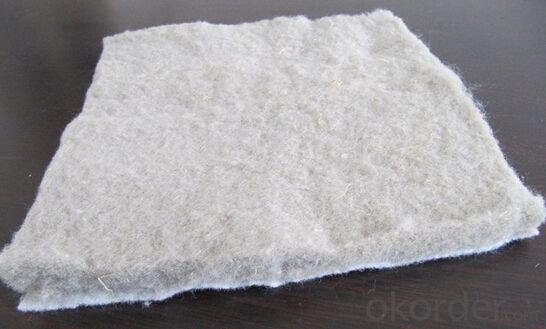

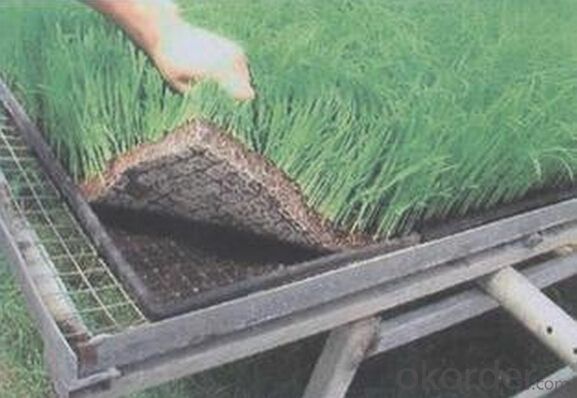

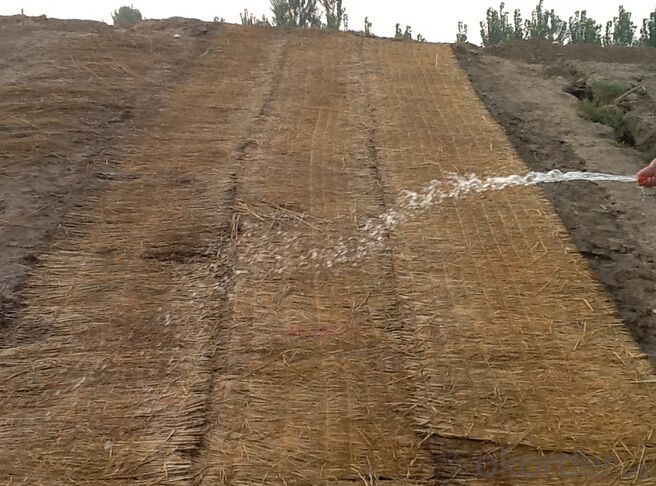
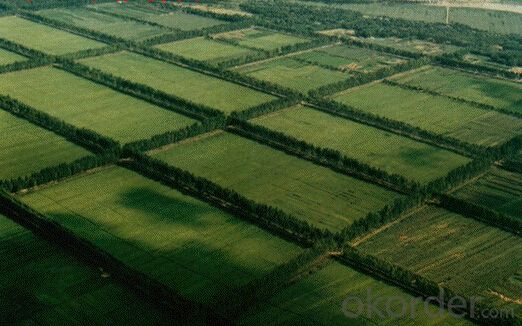
- Q:What materials are geogrids made of?
- Geogrids are typically made from polymer materials such as polypropylene or polyester. These polymers are chosen for their high tensile strength and durability, allowing geogrids to provide effective reinforcement in various civil engineering and construction applications.
- Q:What is the difference between a woven and a non-woven geogrid?
- A woven geogrid is made from weaving durable synthetic fibers together, creating a strong and flexible grid structure. On the other hand, a non-woven geogrid is formed by bonding synthetic fibers together using heat and pressure, resulting in a uniform and stable matrix. Overall, the key difference lies in the manufacturing process and structure, with woven geogrids offering higher tensile strength and stability, while non-woven geogrids provide better filtration and drainage properties.
- Q:What is the meaning of the highway geogrid gsl50/hdpe
- 150 refers to the tensile strength is 150KN, it is impossible to two-way tensile plastic geogrid, plastic composite geogrid material is HDPE material,
- Q:Can geogrids be used in stabilization of mine tailings ponds?
- Yes, geogrids can be used in the stabilization of mine tailings ponds. Geogrids are engineered materials that provide reinforcement and stability to soil and other materials. They can be used to reinforce the embankments and slopes of mine tailings ponds, preventing erosion and enhancing overall stability. Additionally, geogrids can improve the long-term performance of the pond by reducing settlement and increasing load-bearing capacity.
- Q:How do geogrids help in the construction of embankments?
- Geogrids help in the construction of embankments by providing reinforcement and stability to the soil. They are placed within the embankment layers to distribute the loads, reduce settlement, and prevent soil erosion. Geogrids also improve the overall strength of the embankment, allowing for the construction of steeper slopes and reducing the risk of slope failures.
- Q:The dam is protection of geomembrane or gabion.
- There is a need to gabion can call ID
- Q:Glass fiber grille modified asphalt, polyester grille coated PVC.
- This is the business secret of the production enterprise.
- Q:How much is the horizontal overlap length of the steel plastic geogrid
- 10-15cm if the geogrid is a longitudinal lap not less than 20cm reference geogrid construction technology
- Q:Can geogrids be used in landfills?
- Yes, geogrids can be used in landfills. Geogrids are commonly used in landfill engineering as they provide reinforcement and stabilization to the landfill slopes and walls, preventing soil erosion and promoting the overall stability of the landfill structure.
- Q:Are geogrids resistant to chemical degradation?
- Yes, geogrids are generally resistant to chemical degradation. They are designed to withstand exposure to various chemicals, including acids, alkalis, and hydrocarbons, without significant deterioration or loss of strength. However, the specific resistance may vary depending on the type of geogrid and the specific chemicals involved.
1. Manufacturer Overview |
|
|---|---|
| Location | |
| Year Established | |
| Annual Output Value | |
| Main Markets | |
| Company Certifications | |
2. Manufacturer Certificates |
|
|---|---|
| a) Certification Name | |
| Range | |
| Reference | |
| Validity Period | |
3. Manufacturer Capability |
|
|---|---|
| a)Trade Capacity | |
| Nearest Port | |
| Export Percentage | |
| No.of Employees in Trade Department | |
| Language Spoken: | |
| b)Factory Information | |
| Factory Size: | |
| No. of Production Lines | |
| Contract Manufacturing | |
| Product Price Range | |
Send your message to us
Nutrition Geotextile Use in Ecological Prevention and Control
- Loading Port:
- Qingdao
- Payment Terms:
- TT OR LC
- Min Order Qty:
- 5000 m²
- Supply Capability:
- 2000000 m²/month
OKorder Service Pledge
OKorder Financial Service
Similar products
New products
Hot products
Related keywords

